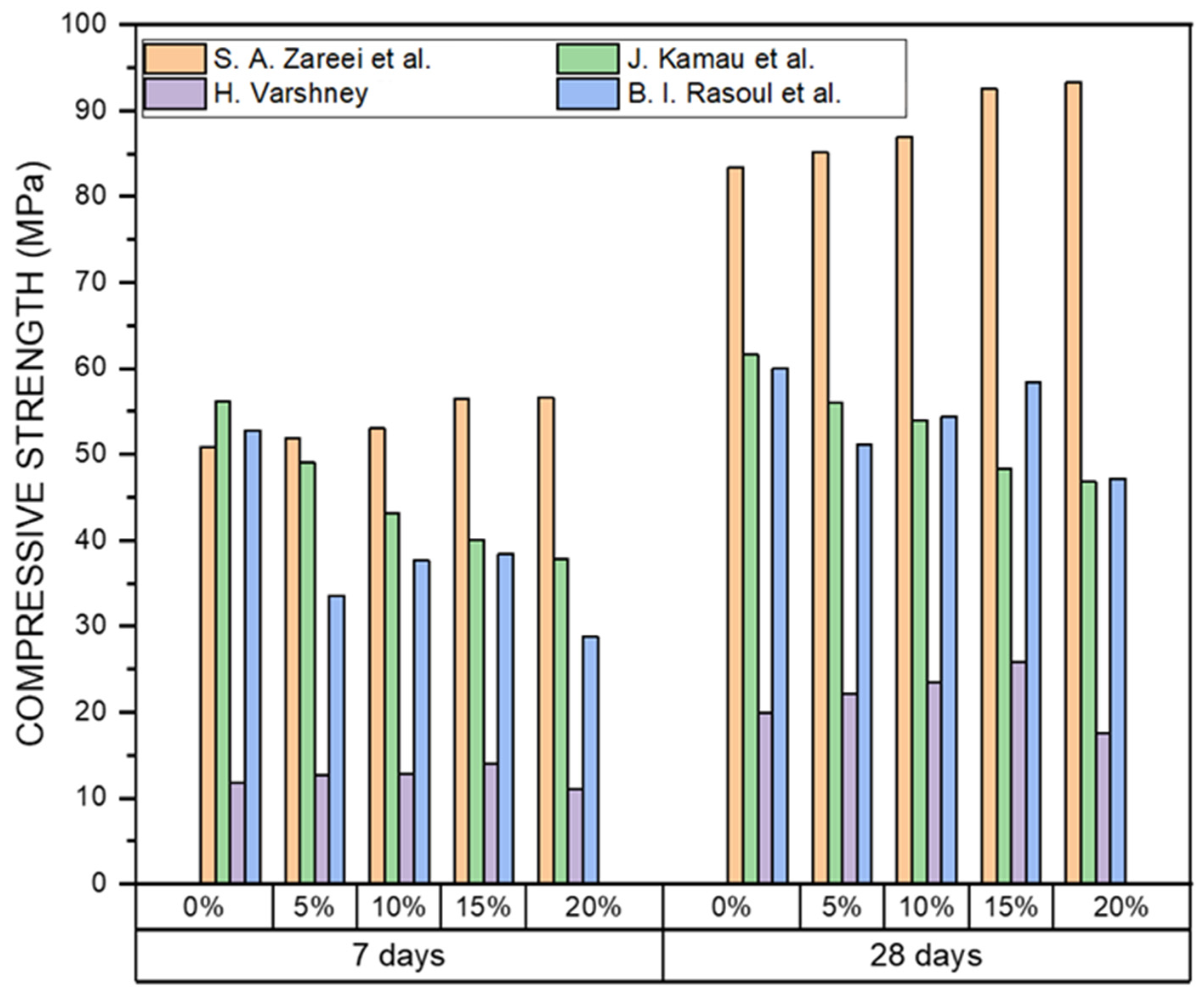Rice Husk Ash in Concrete
Abstract
1. Introduction
2. RHA Production
3. RHA Particle Properties
3.1. Physical Properties of RHA
3.2. Chemical Composition of RHA
3.2.1. Oxide Composition of RHA
3.2.2. Pozzolanic Properties of RHA
3.3. Microstructure of RHA
3.4. Mineralogical Compositions and Morphology of RHA
4. The Effect of RHA on the Fresh Properties of Concrete
4.1. Workability
4.2. Consistency and Setting Times
5. The Effect of RHA on the Mechanical Properties of Concrete
5.1. Compressive Strength
| References | Material/s and Method/s | Result/s |
|---|---|---|
| [41] |
|
|
| [42] |
|
|
| [44] |
|
|
| [45] |
|
|
| [79] |
|
|
| [80] |
|
|
| [81] |
|
|
| [82] |
|
|
| [83] |
|
|
| [84] |
|
|
5.2. Tensile Strength
| References | Material/s and Method/s | Result/s |
|---|---|---|
| [42] |
|
|
| [79] |
|
|
| [82] |
|
|
5.3. Flexural Strength
6. The Effect of RHA on the Durability Properties of Concrete
6.1. Water Absorption
6.2. Chloride Resistance
6.3. Corrosion Resistance
6.4. Sulphate Resistance
7. Conclusions
- RHA particle properties: The microstructure of RHA particles is typically irregular in shape, with porous structures on the surface, non-uniform in dispersion, and discrete widely. The chemical composition of RHA comprises a high amount of silica content, which is well above 70%, in some cases reaching up to 97%, that gives excellent pozzolanic properties. The silica is mainly present as an amorphous phase with Quartz (SiO2) and Cristobalite (SiO2). The pozzolanic reactivity of RHA is determined not only by its amorphous content, but also by its specific surface area and particle fineness, which can be improved by using controlled combustion and grinding. The finer RHA particles release more silica and have a better filler effect, resulting in higher pozzolanic reactivity. The pore structures of RHA varied, including small size pits and large connected pores, depending on the source of rice husk, calcination temperature, burning time, holding time, and so on. As a result, in addition to selecting the type of rice, a proper incineration and grinding process should be used to produce RHA that has higher pozzolanic reactivity and can be used effectively as a material for partial cement replacement of cement.
- RHA on concrete properties: RHA has a strong potential to replace cement by up to 10% to 20% without compromising concrete performance in terms of workability, strength, and durability. The workability of concrete generally decreases with increasing RHA content. The pozzolanic reactivity and filler effect of RHA significantly enhance the strength of concrete by providing a dense microstructure through the formation of additional C-S-H gels. The densification of the concrete matrix also results in a lower rate of water absorption and penetration of chemical ions into the concrete. As the pozzolanic activity of RHA in concrete is influenced by a variety of factors, it is necessary to establish a set of criteria within which they vary, so that those interested in using RHA in concrete can obtain RHA with optimal properties in terms of influence on concrete workability, strength, and durability. Indeed, more and more experimental work under various scenarios is required to make this happen.
- RHA on concrete sustainability: RHA production uses less energy and emits fewer greenhouse gases than cement. The use of RHA as a partial cement replacement in concrete production could significantly reduce the carbon footprint of concrete. It also contributes to the beneficial disposal of agricultural byproducts, thereby reducing adverse environmental effects. Indeed, improving the pozzolanic properties of RHA is critical to achieving greater sustainability in the concrete industry. It would allow for a high proportion of cement to be replaced, resulting in green concrete, which would ultimately contribute significantly to combating climate change, achieving the Sustainable Development Goals (SDG13), and contributing to a circular economy in the construction industry.
Author Contributions
Funding
Institutional Review Board Statement
Informed Consent Statement
Data Availability Statement
Conflicts of Interest
References
- Schneider, M. The cement industry on the way to a low-carbon future. Cem. Concr. Res. 2019, 124, 105792. [Google Scholar] [CrossRef]
- Andrew, R.M. Global CO2 emissions from cement production. Earth Syst. Sci. Data 2018, 10, 195–217. [Google Scholar] [CrossRef]
- UNFCCC. Adoption of the Paris Agreement—Paris Agreement Text English. Available online: https://unfccc.int/sites/default/files/english_paris_agreement.pdf (accessed on 18 December 2022).
- Praveenkumar, S.; Sankarasubramanian, G. Stimulus of Ago-Industrial Waste to Make Eco-Concrete-A Review Stimulus of Agro-industrial Waste to Make Eco-Concrete—A Review. 2018. Available online: https://www.researchgate.net/publication/326876669 (accessed on 13 December 2022).
- Al-Mansour, A.; Chow, C.L.; Feo, L.; Penna, R.; Lau, D. Green Concrete: By-Products Utilization and Advanced Approaches. Sustainability 2019, 11, 5145. [Google Scholar] [CrossRef]
- He, J.; Kawasaki, S.; Achal, V. The Utilization of Agricultural Waste as Agro-Cement in Concrete: A Review. Sustainability 2020, 12, 6971. [Google Scholar] [CrossRef]
- Yehualaw, M.D.; Alemu, M.; Hailemariam, B.Z.; Vo, D.-H.; Taffese, W.Z. Aquatic Weed for Concrete Sustainability. Sustainability 2022, 14, 15501. [Google Scholar] [CrossRef]
- Zerihun, B.; Yehualaw, M.D.; Vo, D.-H. Effect of Agricultural Crop Wastes as Partial Replacement of Cement in Concrete Production. Adv. Civ. Eng. 2022, 2022, 5648187. [Google Scholar] [CrossRef]
- Gedefaw, A.; Yifru, B.W.; Endale, S.A.; Habtegebreal, B.T.; Yehualaw, M.D. Experimental Investigation on the Effects of Coffee Husk Ash as Partial Replacement of Cement on Concrete Properties. Adv. Mater. Sci. Eng. 2022, 2022, 4175460. [Google Scholar] [CrossRef]
- Thomas, B.S. Green concrete partially comprised of rice husk ash as a supplementary cementitious material—A comprehensive review. Renew. Sustain. Energy Rev. 2018, 82, 3913–3923. [Google Scholar] [CrossRef]
- FAO. Rice Market Monitor. Food and Agriculture Organization. United Nations. Available online: http://www.fao.org/economic/est/publications/rice-publications/rice-market-monitor-rmm/en/ (accessed on 22 August 2021).
- Ramezanianpour, A.A. Rice Husk Ash. In Cement Replacement Materials; Springer: Berlin/Heidelberg, Germany, 2013; pp. 257–298. [Google Scholar] [CrossRef]
- Kwan, W.H.; Wong, Y.S. Acid leached rice husk ash (ARHA) in concrete: A review. Mater. Sci. Energy Technol. 2020, 3, 501–507. [Google Scholar] [CrossRef]
- Siddika, A.; Al Mamun, A.; Alyousef, R.; Mohammadhosseini, H. State-of-the-art-review on rice husk ash: A supplementary cementitious material in concrete. J. King Saud Univ. Eng. Sci. 2020, 33, 294–307. [Google Scholar] [CrossRef]
- Hasan, N.M.S.; Sobuz, H.R.; Khan, M.H.; Mim, N.J.; Meraz, M.; Datta, S.D.; Rana, J.; Saha, A.; Akid, A.S.M.; Mehedi, T.; et al. Integration of Rice Husk Ash as Supplementary Cementitious Material in the Production of Sustainable High-Strength Concrete. Materials 2022, 15, 8171. [Google Scholar] [CrossRef] [PubMed]
- Amin, M.N.; Al-Hashem, M.N.; Ahmad, A.; Khan, K.; Ahmad, W.; Qadir, M.G.; Imran, M.; Al-Ahmad, Q.M.S. Application of Soft-Computing Methods to Evaluate the Compressive Strength of Self-Compacting Concrete. Materials 2022, 15, 7800. [Google Scholar] [CrossRef] [PubMed]
- Zhang, Z.; Yang, F.; Liu, J.-C.; Wang, S. Eco-friendly high strength, high ductility engineered cementitious composites (ECC) with substitution of fly ash by rice husk ash. Cem. Concr. Res. 2020, 137, 106200. [Google Scholar] [CrossRef]
- Jongpradist, P.; Homtragoon, W.; Sukkarak, R.; Kongkitkul, W.; Jamsawang, P. Efficiency of Rice Husk Ash as Cementitious Material in High-Strength Cement-Admixed Clay. Adv. Civ. Eng. 2018, 2018, 8346319. [Google Scholar] [CrossRef]
- Rajasegar, M.; Kumaar, C.M. Hybrid effect of poly vinyl alcohol, expansive minerals, nano-silica and rice husk ash on the self-healing ability of concrete. Mater. Today Proc. 2020, 45, 5944–5952. [Google Scholar] [CrossRef]
- Tran, H.-B.; Le, V.-B.; Phan, V.T.-A. Mechanical Properties of High Strength Concrete Containing Nano SiO2 Made from Rice Husk Ash in Southern Vietnam. Crystals 2021, 11, 932. [Google Scholar] [CrossRef]
- Muhammad, A.; Thienel, K.-C.; Sposito, R. Suitability of Blending Rice Husk Ash and Calcined Clay for the Production of Self-Compacting Concrete: A Review. Materials 2021, 14, 6252. [Google Scholar] [CrossRef]
- Marangu, J.M.; M’Thiruaine, C.M.; Bediako, M. Physicochemical Properties of Hydrated Portland Cement Blended with Rice Husk Ash. J. Chem. 2020, 2020, 5304745. [Google Scholar] [CrossRef]
- Thiedeitz, M.; Schmidt, W.; Härder, M.; Kränkel, T. Performance of Rice Husk Ash as Supplementary Cementitious Material after Production in the Field and in the Lab. Materials 2020, 13, 4319. [Google Scholar] [CrossRef]
- Tulashie, S.K.; Ebo, P.; Ansah, J.K.; Mensah, D. Production of Portland pozzolana cement from rice husk ash. Materialia 2021, 16, 101048. [Google Scholar] [CrossRef]
- Fapohunda, C.; Akinbile, B.; Shittu, A. Structure and properties of mortar and concrete with rice husk ash as partial replacement of ordinary Portland cement—A review. Int. J. Sustain. Built Environ. 2017, 6, 675–692. [Google Scholar] [CrossRef]
- Saad, S.A.; Shafiq, N.; Osman, M.M.; Masjuki, S.A. Compressive Strength and Microstructure Analysis of Treated Rice Husk Ash (TRHA) Incorporated Mortar. Int. J. Eng. Technol. 2018, 7, 388–391. [Google Scholar] [CrossRef]
- Umasabor, R.I.; Okovido, J.O. Fire resistance evaluation of rice husk ash concrete. Heliyon 2018, 4, 1–14. [Google Scholar] [CrossRef] [PubMed]
- Kameshwar, P.; Athira, G.; Bahurudeen, A.; Nanthagopalan, P. Suitable pretreatment process for rice husk ash towards dosage optimization and its effect on properties of cementitious mortar. Struct. Concr. 2020, 22, E501–E513. [Google Scholar] [CrossRef]
- Isberto, C.D. Optimized Preparation of Rice Husk Ash (Rha) as a Supplementary Cementitious Material. GEOMATE J. 2019, 16, 56–61. [Google Scholar] [CrossRef]
- Mosaberpanah, M.A.; Umar, S.A. Utilizing Rice Husk Ash as Supplement to Cementitious Materials on Performance of Ultra High Performance Concrete:—A review. Mater. Today Sustain. 2020, 7, 100030. [Google Scholar] [CrossRef]
- Krishna, N.K.; Sandeep, S.; Mini, K.M. Study on concrete with partial replacement of cement by rice husk ash. IOP Conf. Ser. Mater. Sci. Eng. 2016, 149, 012109. [Google Scholar] [CrossRef]
- Mohseni, E.; Naseri, F.; Amjadi, R.; Khotbehsara, M.M.; Ranjbar, M.M. Microstructure and durability properties of cement mortars containing nano-TiO2 and rice husk ash. Constr. Build. Mater. 2016, 114, 656–664. [Google Scholar] [CrossRef]
- Kannan, V.; Ganesan, K. Effect of Tricalcium Aluminate on Durability Properties of Self-Compacting Concrete Incorporating Rice Husk Ash and Metakaolin. J. Mater. Civ. Eng. 2016, 28, 04015063. [Google Scholar] [CrossRef]
- Saravanan, M.; Sivaraja, M. Mechanical Behavior of Concrete Modified by Replacement of Cement by Rice Husk Ash. Braz. Arch. Biol. Technol. 2016, 59. [Google Scholar] [CrossRef][Green Version]
- Balapour, M.; Hajibandeh, E.; Ramezanianpour, A. Engineering Properties and Durability of Mortars Containing New Nano Rice Husk Ash (RHA). In High Tech Concrete: Where Technology and Engineering Meet—Proceedings of the 2017 fib Symposium, Maastricht, The Netherlands, 12–14 June 2017; Springer: Cham, Switzerland, 2017; pp. 199–206. [Google Scholar] [CrossRef]
- Wang, W.; Meng, Y.; Wang, D. Effect of Rice Husk Ash on High-Temperature Mechanical Properties and Microstructure of Concrete. Kem. u Ind. 2017, 66, 157–164. [Google Scholar] [CrossRef]
- Abiodun, Y.O.; Jimoh, A.A. Microstructural characterisation, physical and chemical properties of rice husk ash as viable Pozzolan in building material: A case study of some Nigerian grown rice varieties. Niger. J. Technol. 2018, 37, 71. [Google Scholar] [CrossRef]
- Kumar, S.; Tech, M.S.-C. Engineering. International Research Impact of Rice Husk Ash on Cement Concrete. Available online: www.ijtsrd.com (accessed on 18 December 2022).
- Hussin, T.A.R.; Parasuraman, J.A. Partial Replacement of Cement with Commercial Availabe Rice Husk Ash in Concrete. Infrastruct. Univ. Kuala Lumpur Res. J. 2018, 1, 1–9. [Google Scholar]
- Saand, A.; Ali, T.; Keerio, M.A.; Bangwar, D.K. Experimental Study on the Use of Rice Husk Ash as Partial Cement Replacement in Aerated Concrete. Eng. Technol. Appl. Sci. Res. 2019, 9, 4534–4537. [Google Scholar] [CrossRef]
- Botchway, D.N.-L.; Afrifa, R.O.; Henaku, C.Y. Effect of Partial Replacement of Ordinary Portland Cement (OPC) with Ghanaian Rice Husk Ash (RHA) on the Compressive Strength of Concrete. Open J. Civ. Eng. 2020, 10, 353–363. [Google Scholar] [CrossRef]
- Ali, T.; Saand, A.; Bangwar, D.; Buller, A.; Ahmed, Z. Mechanical and Durability Properties of Aerated Concrete Incorporating Rice Husk Ash (RHA) as Partial Replacement of Cement. Crystals 2021, 11, 604. [Google Scholar] [CrossRef]
- Kaplan, G.; Elmekahal, M.A.S. Microstructure and durability properties of lightweight and high-performance sustainable cement-based composites with rice husk ash. Environ. Sci. Pollut. Res. 2021, 28, 52936–52962. [Google Scholar] [CrossRef]
- Reddy, K.R.; Harihanandh, M.; Murali, K. Strength performance of high-grade concrete using rice husk ash (RHA) as cement replacement material. Mater. Today Proc. 2021, 46, 8822–8825. [Google Scholar] [CrossRef]
- Vijaya, S.K.; Jagadeeswari, K.; Srinivas, K. Behaviour of M60 grade concrete by partial replacement of cement with fly ash, rice husk ash and silica fume. Mater. Today Proc. 2020, 37, 2104–2108. [Google Scholar] [CrossRef]
- Raheem, A.A.; Kareem, M.A. Chemical Composition and Physical Characteristics of Rice Husk Ash Blended Cement. Int. J. Eng. Res. Afr. 2017, 32, 25–35. [Google Scholar] [CrossRef]
- Hossain, S.S.; Bhardwaj, A.; Majhi, M.R. Preparation & Characterization of Insulating Rice Husk Ash Refractory Using Rice Husk as Pore Forming Agent. Int. J. Sci. Res. 2013, 5, 457–460. [Google Scholar]
- Zareei, S.A.; Ameri, F.; Dorostkar, F.; Ahmadi, M. Rice husk ash as a partial replacement of cement in high strength concrete containing micro silica: Evaluating durability and mechanical properties. Case Stud. Constr. Mater. 2017, 7, 73–81. [Google Scholar] [CrossRef]
- Egbe, J.G.; Ettah, E.B.; Ubi, E.S.; Okon, E. Investigation of Rice Husk Ash (RHA) as a Supplement in Cement for Building Applications. Civ. Eng. Res. J. 2018, 6, 555681. [Google Scholar] [CrossRef]
- Gill, A.S.; Siddique, R. Durability properties of self-compacting concrete incorporating metakaolin and rice husk ash. Constr. Build. Mater. 2018, 176, 323–332. [Google Scholar] [CrossRef]
- Kamau, J.; Ahmed, A.; Ngong, K. Sulfate Resistance of Rice Husk Ash Concrete. MATEC Web Conf. 2018, 199, 02006. [Google Scholar] [CrossRef]
- Raisi, E.M.; Amiri, J.V.; Davoodi, M.R. Mechanical performance of self-compacting concrete incorporating rice husk ash. Constr. Build. Mater. 2018, 177, 148–157. [Google Scholar] [CrossRef]
- Urtecho, F.A.M.; Gallo, L.J.O.; Barboza, J.U.R.; Cabrera, E.C. Sustainable Concrete with Rice Husk Ash (RHA) for Marine Structures. MATEC Web Conf. 2019, 303, 05002. [Google Scholar] [CrossRef]
- Sanou, I.; Sawadogo, M.; Seynou, M.; Zerbo, L.; Ouedraogo, R. Study of the Mechanical Behaviour of Mortars Modified with Rice Husk Ash. J. Miner. Mater. Charact. Eng. 2019, 7, 373–384. [Google Scholar] [CrossRef]
- Ahmed, A.; Hyndman, F.; Kamau, J.; Fitriani, H. Rice Husk Ash as a Cement Replacement in High Strength Sustainable Concrete. Mater. Sci. Forum 2020, 1007, 90–98. [Google Scholar] [CrossRef]
- Buyondo, K.A.; Olupot, P.W.; Kirabira, J.B.; Yusuf, A.A. Optimization of production parameters for rice husk ash-based geopolymer cement using response surface methodology. Case Stud. Constr. Mater. 2020, 13, e00461. [Google Scholar] [CrossRef]
- Wang, H.; Zhang, A.-L.; Zhang, L.-C.; Wang, Q.; Han, Y.; Liu, J.-Z.; Gao, X.-J.; Shi, F.-T.; Lin, X.-Y.; Feng, L.-Y. Hydration process of rice husk ash cement paste and its corrosion resistance of embedded steel bar. J. Central South Univ. 2020, 27, 3464–3476. [Google Scholar] [CrossRef]
- Singh, N.S.; Thokchom, S.; Debbarma, R. Correlation study on microstructure and mechanical properties of rice husk ash-Sodium aluminate geopolymer pastes. Adv. Concr. Constr. 2021, 11, 73–80. [Google Scholar] [CrossRef]
- Rahim, M.A.; Ibrahim, N.M.; Idris, Z.; Ghazaly, Z.; Shahidan, S.; Rahim, N.L.; Sofri, L.A.; Isa, N.F. Properties of Concrete with Different Percentange of the Rice Husk Ash (RHA) as Partial Cement Replacement. Mater. Sci. Forum 2014, 803, 288–293. [Google Scholar] [CrossRef]
- Hu, L.; He, Z.; Shao, Y.; Cai, X.; Zhang, S. Microstructure and properties of sustainable cement-based materials using combustion treated rice husk ash. Constr. Build. Mater. 2021, 294, 12348. [Google Scholar] [CrossRef]
- Alex, J.; Dhanalakshmi, J.; Ambedkar, B. Experimental investigation on rice husk ash as cement replacement on concrete production. Constr. Build. Mater. 2016, 127, 353–362. [Google Scholar] [CrossRef]
- Rêgo, J.; Nepomuceno, A.; Figueiredo, E.; Hasparyk, N. Microstructure of cement pastes with residual rice husk ash of low amorphous silica content. Constr. Build. Mater. 2015, 80, 56–68. [Google Scholar] [CrossRef]
- Meddah, M.; Praveenkumar, T.; Vijayalakshmi, M.; Manigandan, S.; Arunachalam, R. Mechanical and microstructural characterization of rice husk ash and Al2O3 nanoparticles modified cement concrete. Constr. Build. Mater. 2020, 255, 119358. [Google Scholar] [CrossRef]
- Zunino, F.; Lopez, M. A methodology for assessing the chemical and physical potential of industrially sourced rice husk ash on strength development and early-age hydration of cement paste. Constr. Build. Mater. 2017, 149, 869–881. [Google Scholar] [CrossRef]
- Kaur, K.; Singh, J.; Kaur, M. Compressive strength of rice husk ash based geopolymer: The effect of alkaline activator. Constr. Build. Mater. 2018, 169, 188–192. [Google Scholar] [CrossRef]
- Mokhtar, M.; Fakhirah, A.; Halim, A.; Mahmod, H.; Nabila, N.; Rashdan, M. Use of Rice Husk and Coconut Shell Ash in Concrete Production. Multidiscip. Appl. Res. Innov. 2022, 3, 205–213. [Google Scholar] [CrossRef]
- Siddika, A.; Al Mamun, A.; Ali, H. Study on concrete with rice husk ash. Innov. Infrastruct. Solut. 2018, 3, 18. [Google Scholar] [CrossRef]
- Wang, J.; Xiao, J.; Zhang, Z.; Han, K.; Hu, X.; Jiang, F. Action mechanism of rice husk ash and the effect on main performances of cement-based materials: A review. Constr. Build. Mater. 2021, 288, 123068. [Google Scholar] [CrossRef]
- Bawankule, S.P.; Balwani, M.S. Effect of Partial Replacement of Cement by Rice Husk Ash in Concrete. Int. J. Sci. Res. 2015, 4, 1572–1574. [Google Scholar]
- Sandhu, R.K.; Siddique, R. Influence of rice husk ash (RHA) on the properties of self-compacting concrete: A review. Constr. Build. Mater. 2017, 153, 751–764. [Google Scholar] [CrossRef]
- Zhang, W.; Liu, H.; Liu, C. Impact of Rice Husk Ash on the Mechanical Characteristics and Freeze–Thaw Resistance of Recycled Aggregate Concrete. Appl. Sci. 2022, 12, 12238. [Google Scholar] [CrossRef]
- Varshney, H. Utilization of Rice Husk Ash in concrete as cement replacement. IOSR J. Mech. Civ. Eng. 2016, 1, 28–33. [Google Scholar] [CrossRef]
- David, J.M. Quantification of Hydration Products in Rice Husk Ash (Rha)-Blended Cement Concrete with Crumb Waste Rubber Tires (Cwrt) & Its Correlation with Mechanical Performance. GEOMATE J. 2022, 23, 126–133. [Google Scholar] [CrossRef]
- Avudaiappan, S.; Prakatanoju, S.; Amran, M.; Aepuru, R.; Saavedra Flores, E.I.; Das, R.; Gupta, R.; Fediuk, R.; Vatin, N. Experimental Investigation and Image Processing to Predict the Properties of Concrete with the Addition of Nano Silica and Rice Husk Ash. Crystals 2021, 11, 1230. [Google Scholar] [CrossRef]
- Al-Alwan, A.A.K.; Al-Bazoon, M.; Mussa, F.I.; Alalwan, H.A.; Shadhar, M.H.; Mohammed, M.M.; Mohammed, M.F. The impact of using rice husk ash as a replacement material in concrete: An experimental study. J. King Saud Univ. Eng. Sci. 2022. [Google Scholar] [CrossRef]
- Ahmed, A.; Ameer, S.; Abbas, S.; Abbass, W.; Razzaq, A.; Mohamed, A.M.; Mohamed, A. Effectiveness of Ternary Blend Incorporating Rice Husk Ash, Silica Fume, and Cement in Preparing ASR Resilient Concrete. Materials 2022, 15, 2125. [Google Scholar] [CrossRef]
- Nalli, B.R.; Vysyaraju, P. Utilization of ceramic waste powder and rice husk ash as a partial replacement of cement in concrete. IOP Conf. Ser. Earth Environ. Sci. 2022, 982, 012003. [Google Scholar] [CrossRef]
- Ahsan, M.B.; Hossain, Z. Use of Rice Husk Ash (RHA) as a Sustainable Cementitious Material for Concrete Construction. In Proceedings of the International Congress and Exhibition Sustainable Civil Infrastructures: Innovative Infrastructure Geotechnology, Sharm El Sheikh, Egypt, 15–19 July 2017. [Google Scholar] [CrossRef]
- Depaa, R.; Priyadarshini, V.; Hemamalinie, A.; Xavier, J.F.; Surendrababu, K. Assessment of strength properties of concrete made with rice husk ash. Mater. Today Proc. 2021, 45, 6724–6727. [Google Scholar] [CrossRef]
- Arivalagan, S. Eco-Friendly Study on Properties of Concrete by Partial Replacement of Cement by Rice Husk ash. Strad Res. 2020, 7, 242–253. [Google Scholar] [CrossRef]
- Dahal, D.; Banstola, R.; Baral, N.; Basnet, K.; Western Regional Campus. Evaluation of Rice Husk Ash as a Partial Replacement of Cement in Self-Compacting Concrete Using Mix Design. Int. J. Eng. Res. 2020, 9, 1402–1409. [Google Scholar] [CrossRef]
- Mukilan, K.; Irene, A.D.K.B.; Shenbagavalli, S.; Muthuprakash, P. Experimental study on steel fibre reinforced concrete with a partial replacement of cement by rice husk ash. IOP Conf. Ser. Mater. Sci. Eng. 2020, 872, 012140. [Google Scholar] [CrossRef]
- Swetha, R.; Rani, M.S.; Raju, U. Experimental Works on Self-Compacting Concrete By Partial Replacement of Rice Husk Ash with Subjected To Acid Attack. Int. J. Innov. Technol. Explor. Eng. 2020, 9, 664–667. [Google Scholar] [CrossRef]
- Neeraja, P. Experimental Investigation on Properties of Concrete Enhanced by Replacement of Cement with Rice Husk Ash as an Admixture. Int. J. Res. Appl. Sci. Eng. Technol. 2021, 9, 1512–1515. [Google Scholar] [CrossRef]
- Rasoul, B.I.; Günzel, F.K.; Rafiq, M.I. Effect of Rice Husk Ash Properties on the Early Age and Long Term Strength of Mortar. In High Tech Concrete: Where Technology and Engineering Meet—Proceedings of the 2017 fib Symposium; Springer: Berlin/Heidelberg, Germany, 2017; pp. 207–214. [Google Scholar] [CrossRef]
- Chachar, Z.A.; Ali, I.; Raza, M.S.; Das Narwani, T.; Raza, I.; Hussain, M. Flexural Behavior of Reinforced Concrete Beams by using Rice Husk Ash as Partial Replacement of Fine Aggregates in Cement Concrete. J. Kejuruter. 2022, 34, 599–604. [Google Scholar] [CrossRef]
- Zahedi, M.; Ramezanianpour, A.A.; Ramezanianpour, A.M. Evaluation of the mechanical properties and durability of cement mortars containing nanosilica and rice husk ash under chloride ion penetration. Constr. Build. Mater. 2015, 78, 354–361. [Google Scholar] [CrossRef]
- Saraswathy, V.; Song, H.-W. Corrosion performance of rice husk ash blended concrete. Constr. Build. Mater. 2007, 21, 1779–1784. [Google Scholar] [CrossRef]
- Vishwakarma, V.; Ramachandran, D.; Anbarasan, N.; Rabel, A.M. Studies of rice husk ash nanoparticles on the mechanical and microstructural properties of the concrete. Mater. Today Proc. 2016, 3, 1999–2007. [Google Scholar] [CrossRef]
- Sombabu, Y.; Prabhakar, K.; Madhuri, P. Partial Replacement of Cement with Rice Husk Ash. Int. Res. J. Eng. Technol. 2017, 4, 251–256. [Google Scholar]
- Mehdizadeh, B.; Jahandari, S.; Vessalas, K.; Miraki, H.; Rasekh, H.; Samali, B. Fresh, Mechanical, and Durability Properties of Self-Compacting Mortar Incorporating Alumina Nanoparticles and Rice Husk Ash. Materials 2021, 14, 6778. [Google Scholar] [CrossRef] [PubMed]
- Kanthe, V.N.; Deo, S.; Murmu, M. Effect of fly ash and rice husk ash as partial replacement of cement on packing density and properties of cement. Int. J. Innov. Technol. Explor. Eng. 2019, 8, 1940–1945. [Google Scholar]
- Praveenkumar, T.R.; Vijayalakshmi, M.M. Microstructural properties of nano-rice husk ash concrete. Nanotechnol. Environ. Eng. 2019, 4, 9. [Google Scholar] [CrossRef]
- Amin, M.; Tayeh, B.A.; Kandil, M.A.; Agwa, I.S.; Abdelmagied, M.F. Effect of rice straw ash and palm leaf ash on the properties of ultrahigh-performance concrete. Case Stud. Constr. Mater. 2022, 17, e01266. [Google Scholar] [CrossRef]
- Bui, L.A.-T.; Chen, C.-T.; Hwang, C.-L.; Wu, W.-S. Effect of silica forms in rice husk ash on the properties of concrete. Int. J. Miner. Met. Mater. 2012, 19, 252–258. [Google Scholar] [CrossRef]
- Rukzon, S.; Chindaprasirt, P. Use of Rice Husk-Bark Ash in Producing Self-Compacting Concrete. Adv. Civ. Eng. 2014, 2014, 429727. [Google Scholar] [CrossRef]
- Cui, L.; Wang, H. Research on the Mechanical Strengths and the Following Corrosion Resistance of Inner Steel Bars of RPC with Rice Husk Ash and Waste Fly Ash. Coatings 2021, 11, 1480. [Google Scholar] [CrossRef]
- Hu, L.; He, Z.; Zhang, S. Sustainable use of rice husk ash in cement-based materials: Environmental evaluation and performance improvement. J. Clean. Prod. 2020, 264, 121744. [Google Scholar] [CrossRef]
- Amran, M.; Fediuk, R.; Murali, G.; Vatin, N.; Karelina, M.; Ozbakkaloglu, T.; Krishna, R.S.; Kumar, A.S.; Kumar, D.S.; Mishra, J. Rice Husk Ash-Based Concrete Composites: A Critical Review of Their Properties and Applications. Crystals 2021, 11, 168. [Google Scholar] [CrossRef]

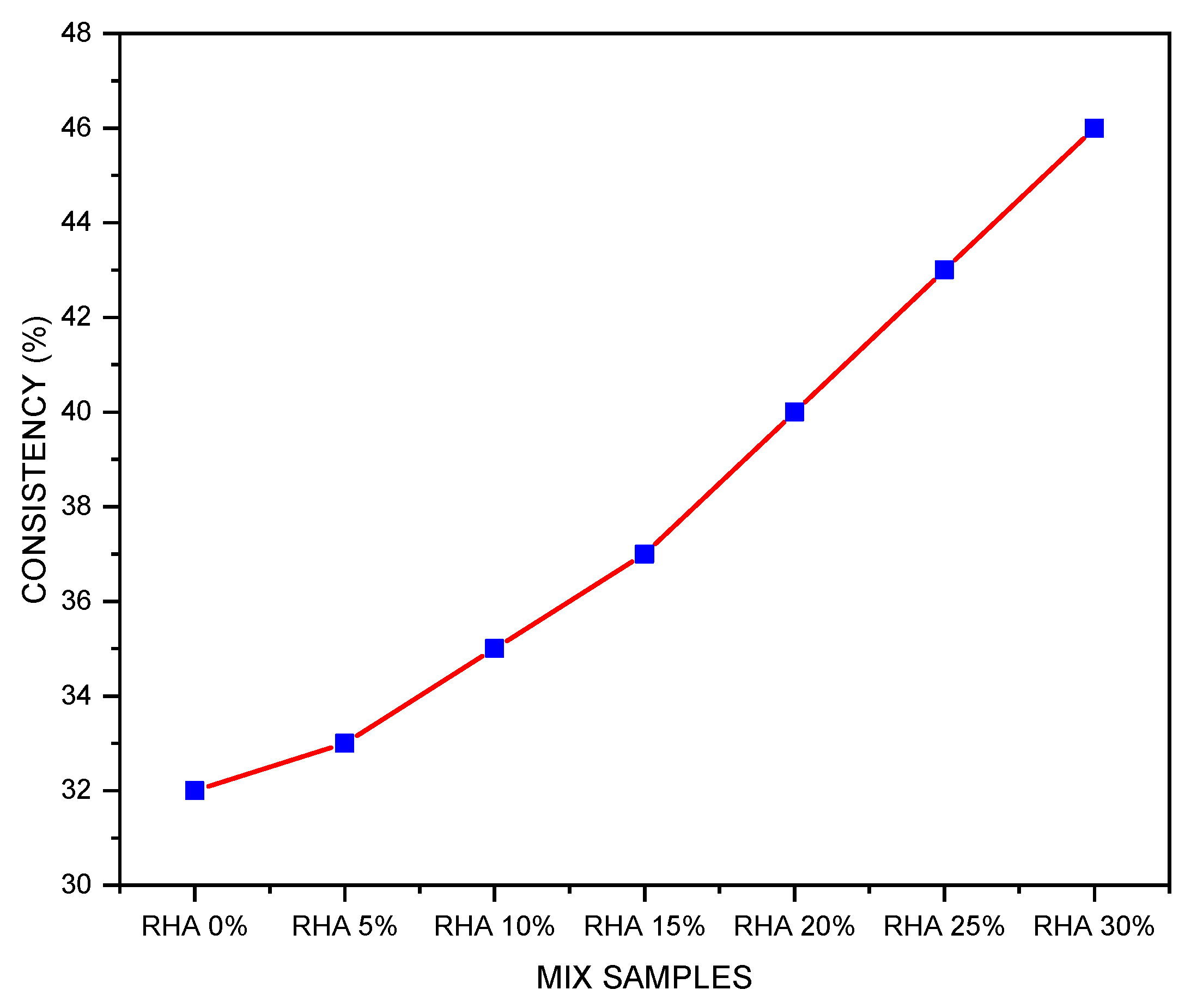
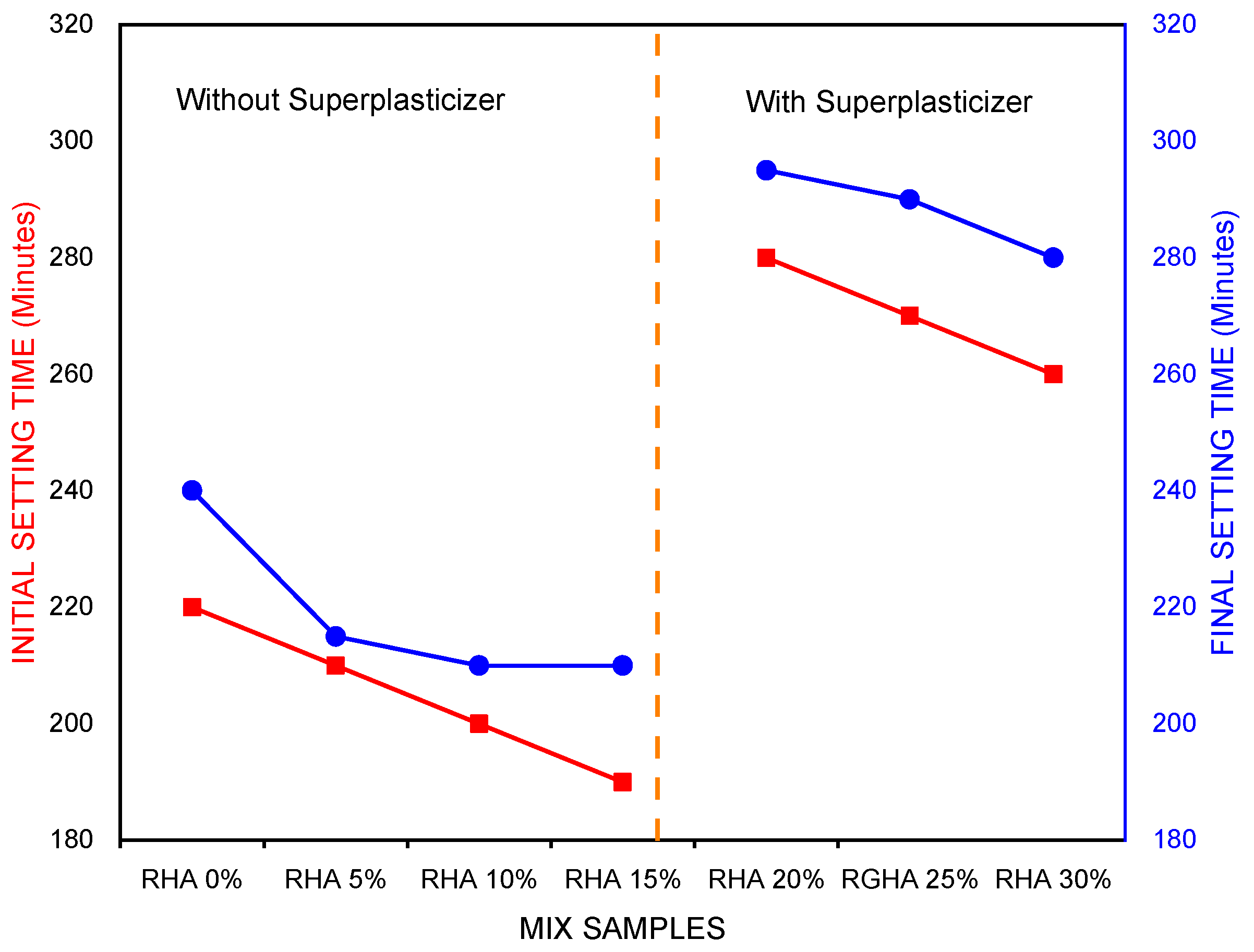
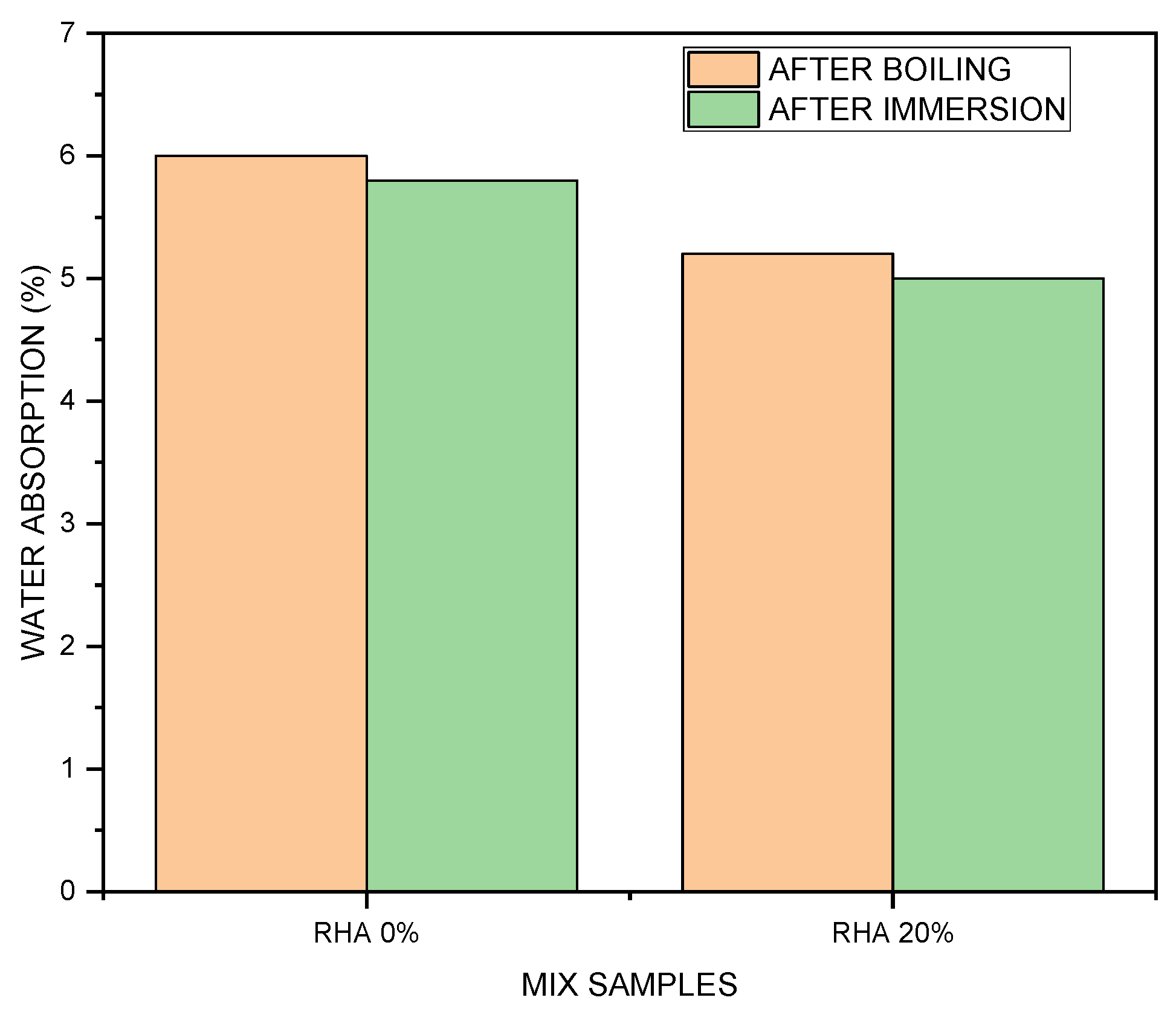

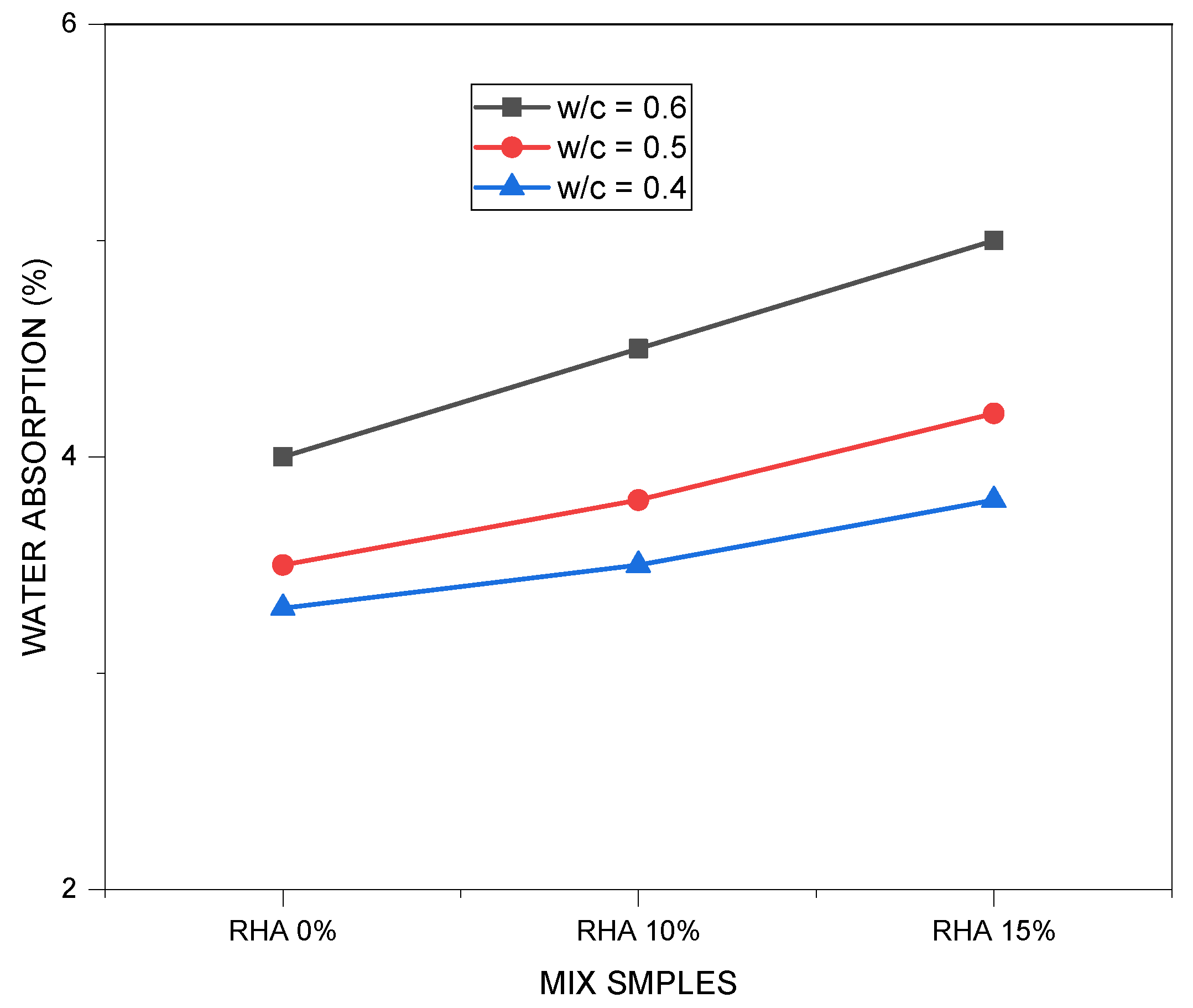
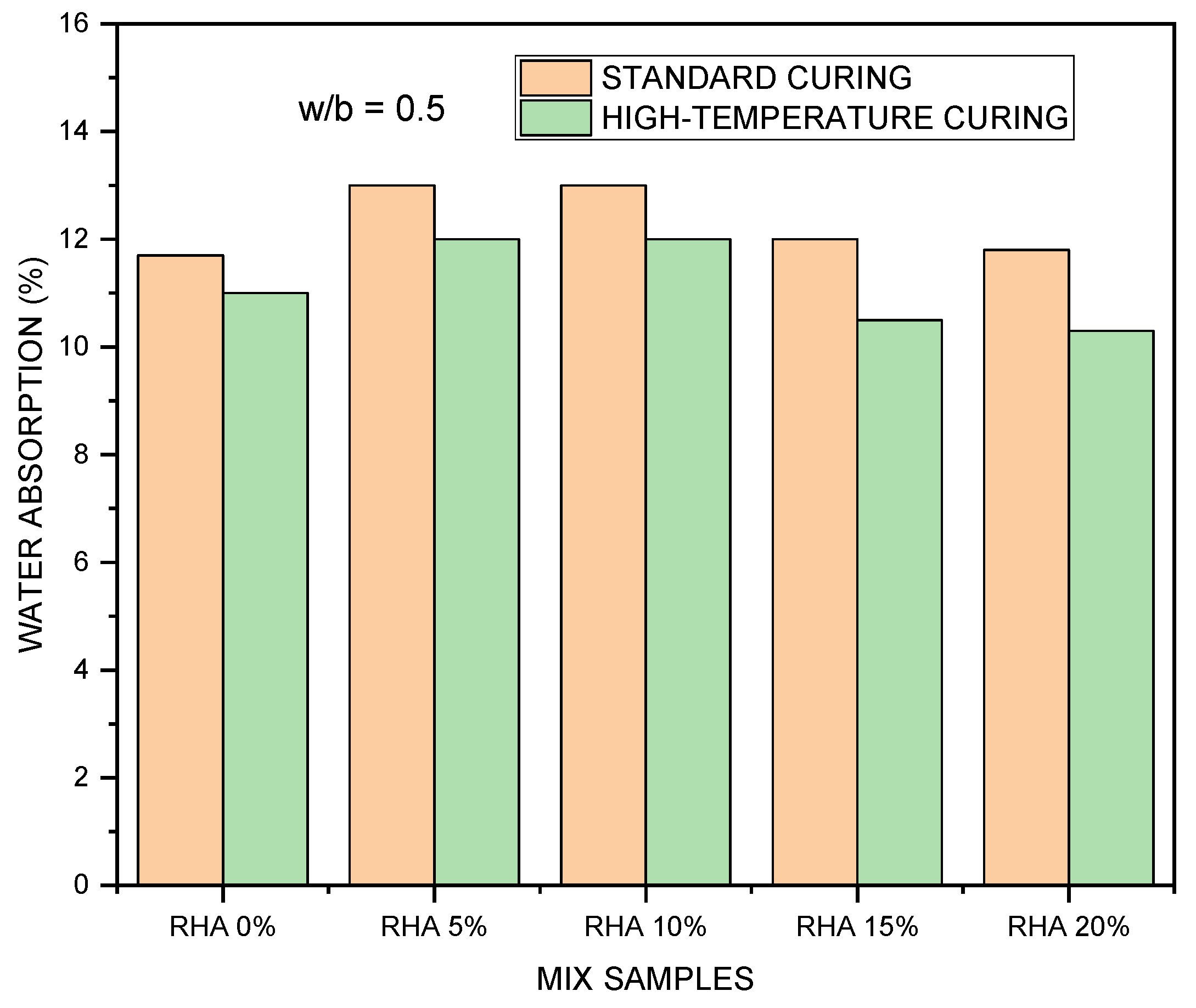
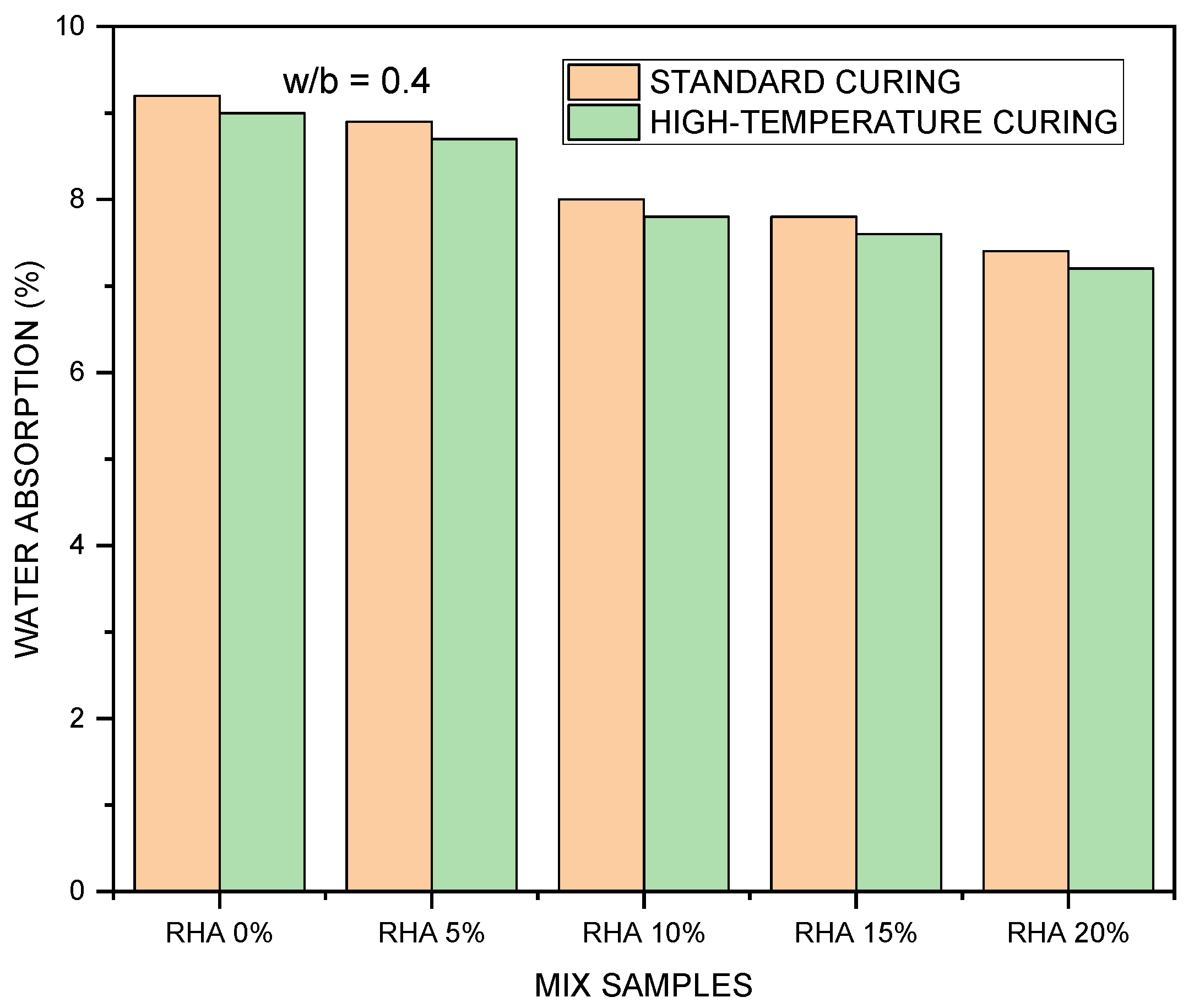
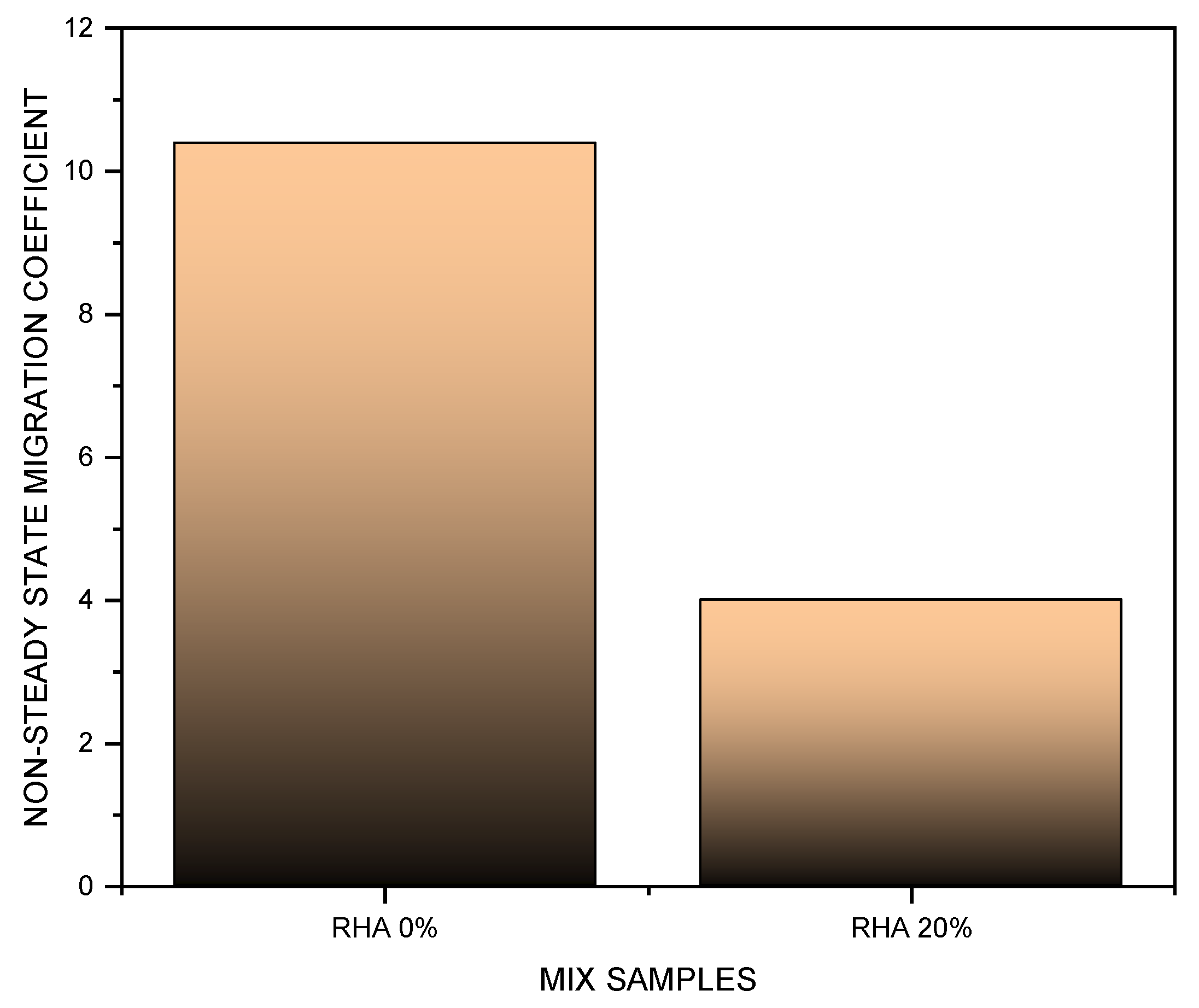
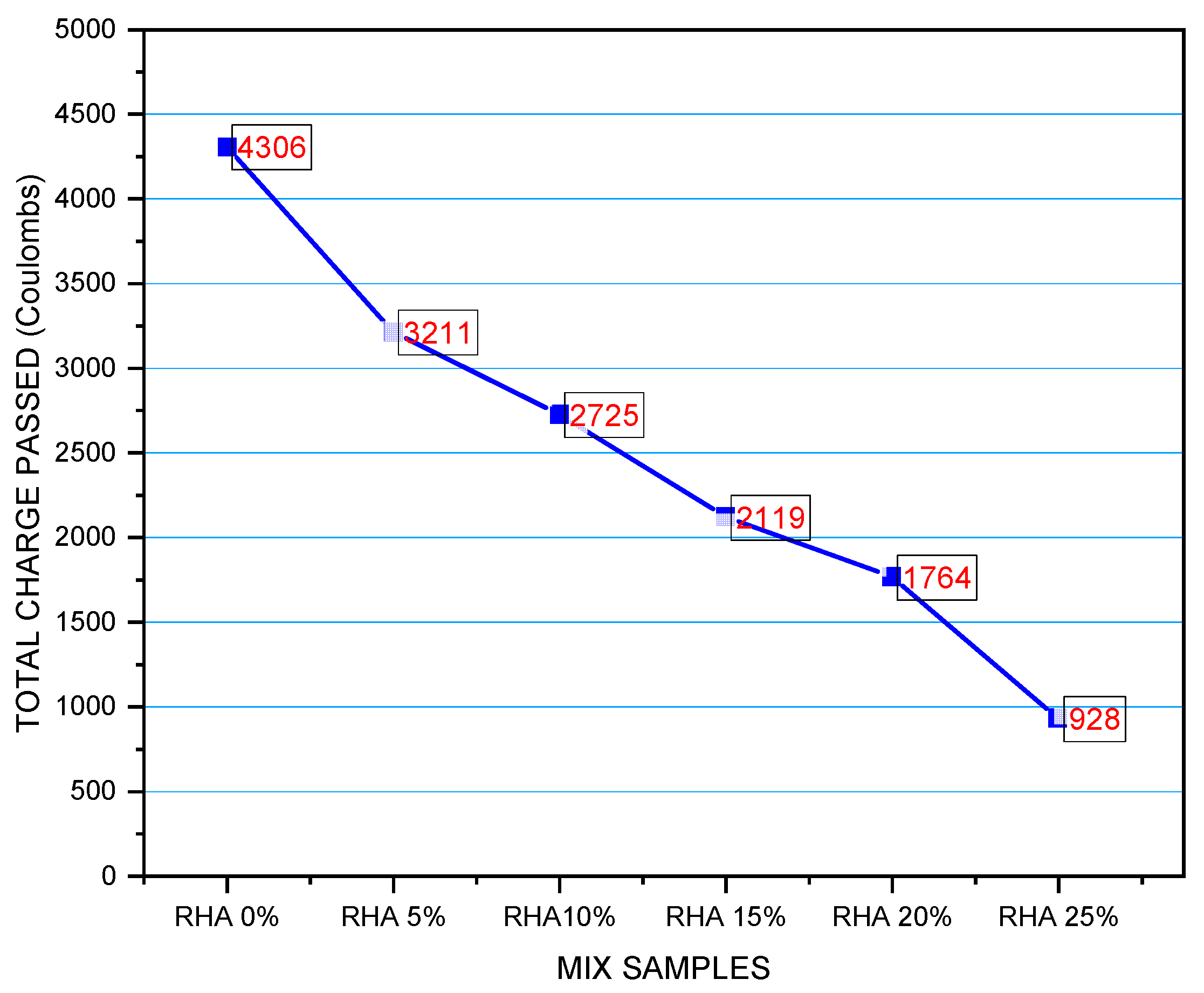

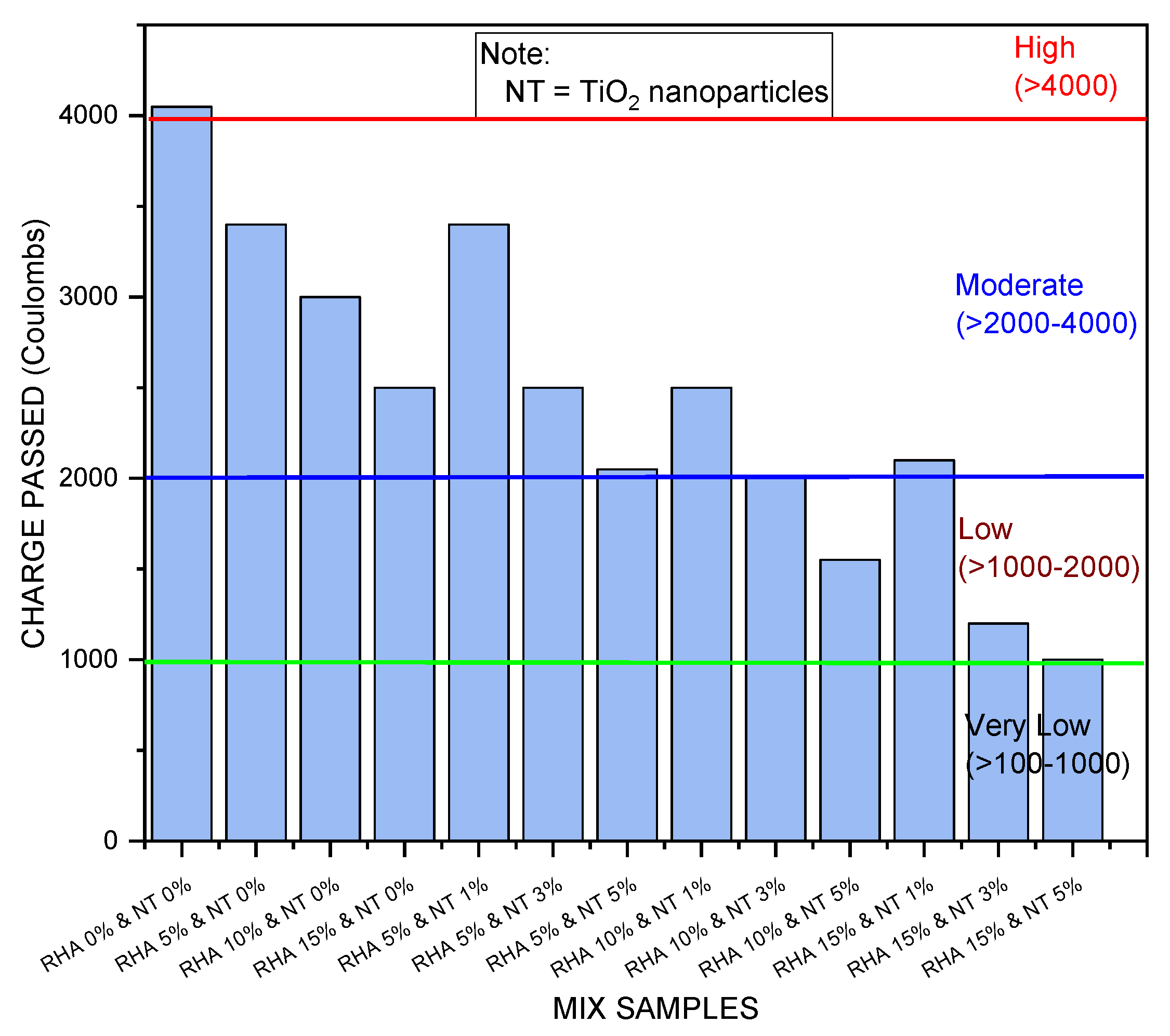
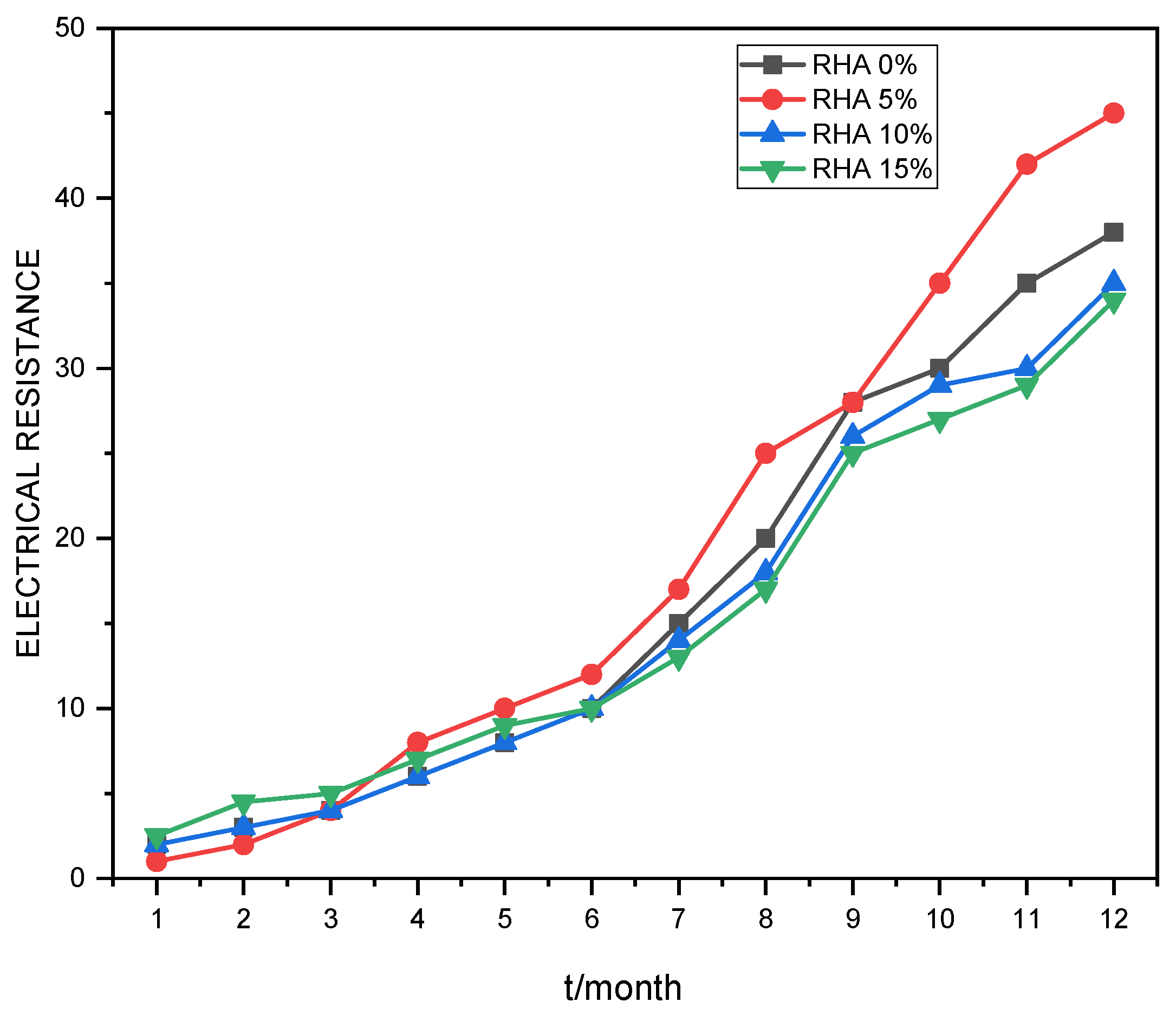
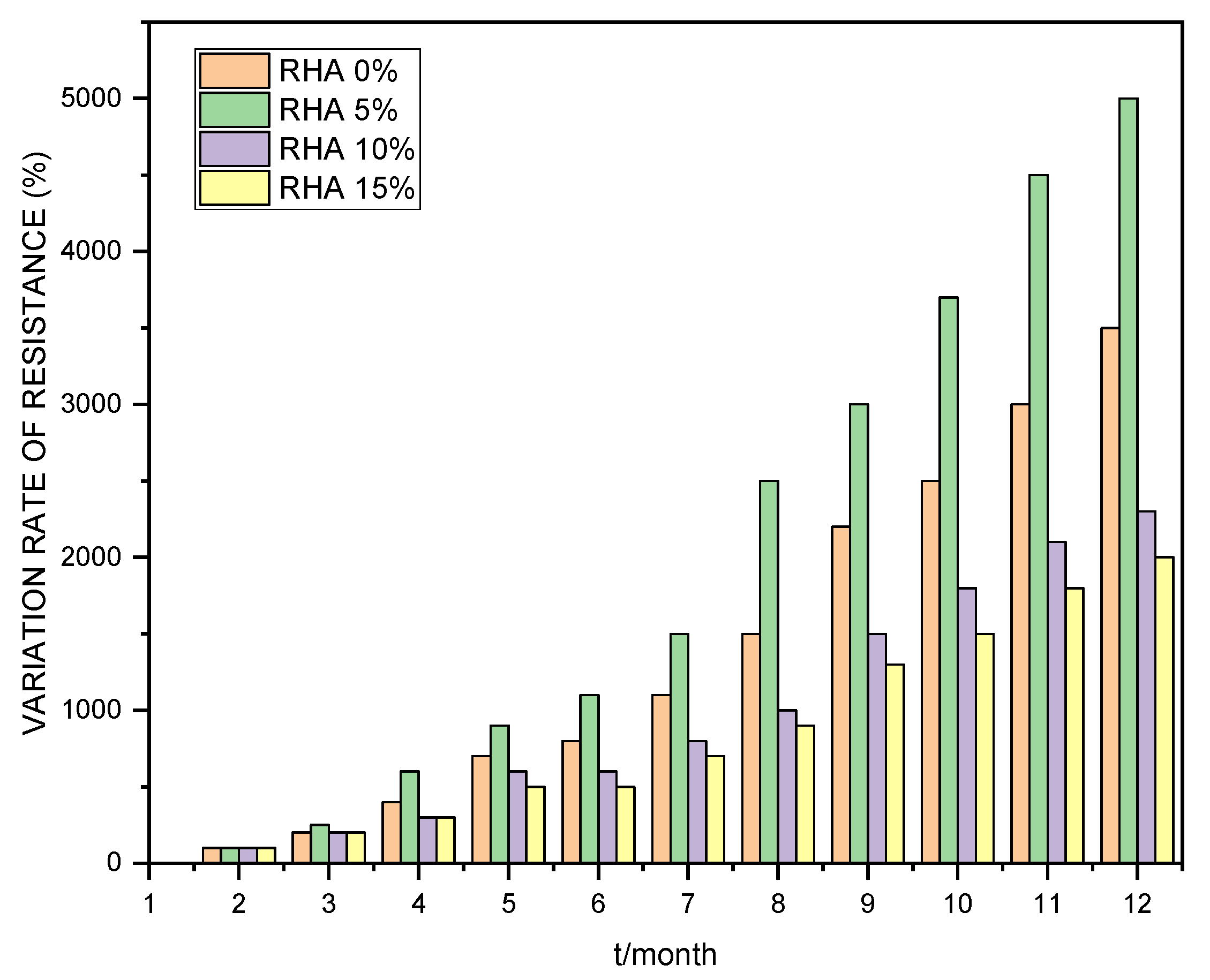

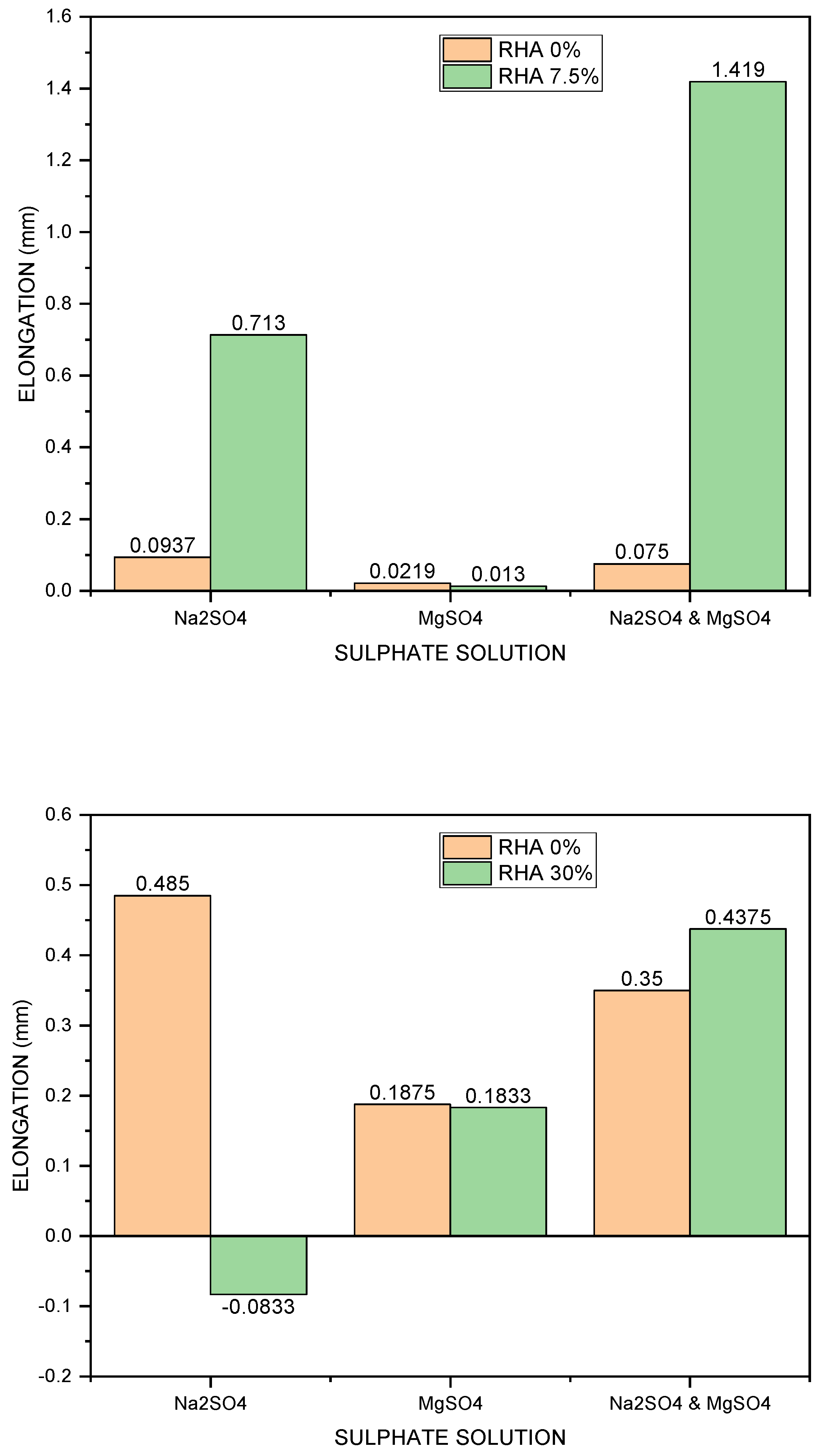
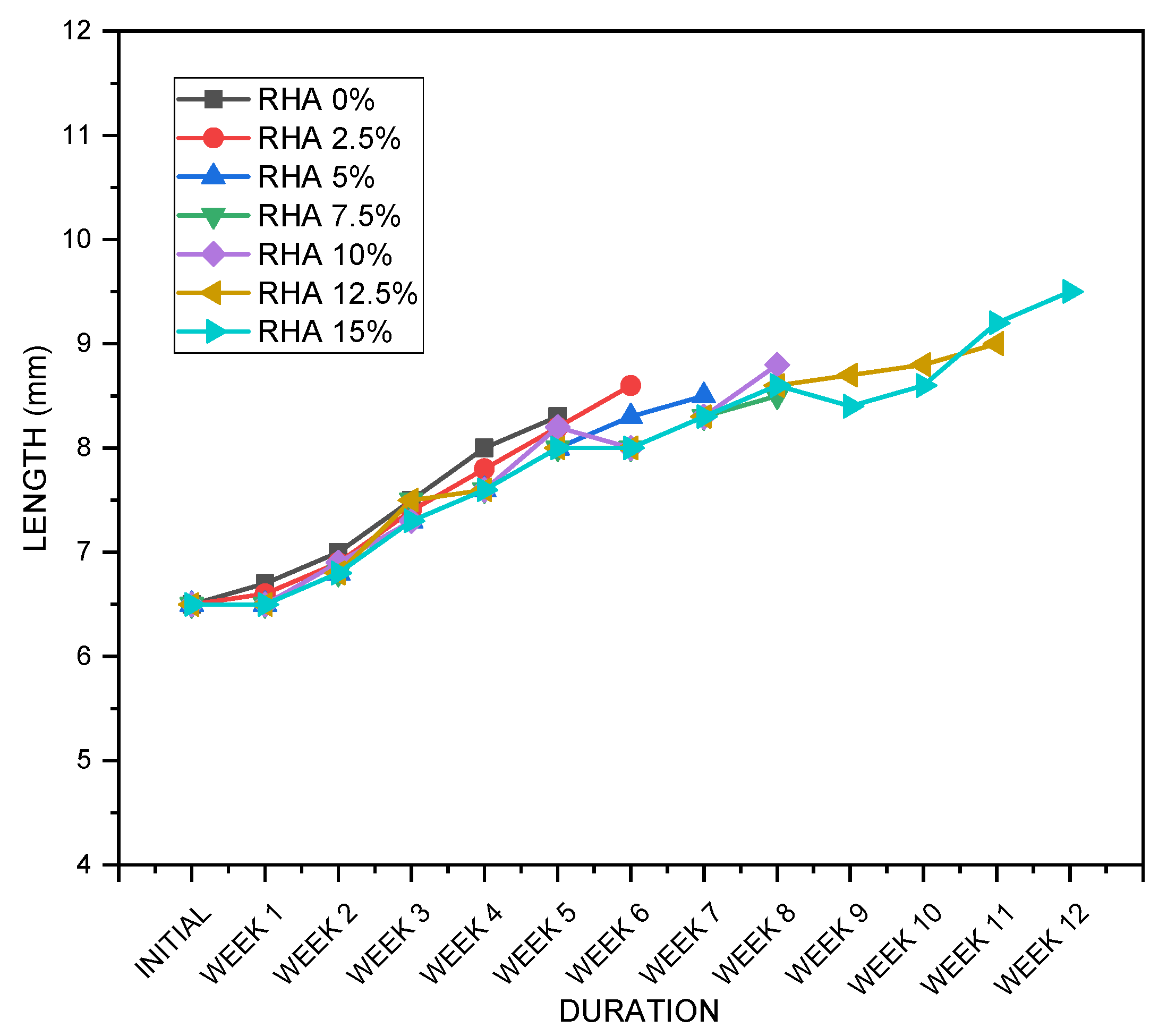
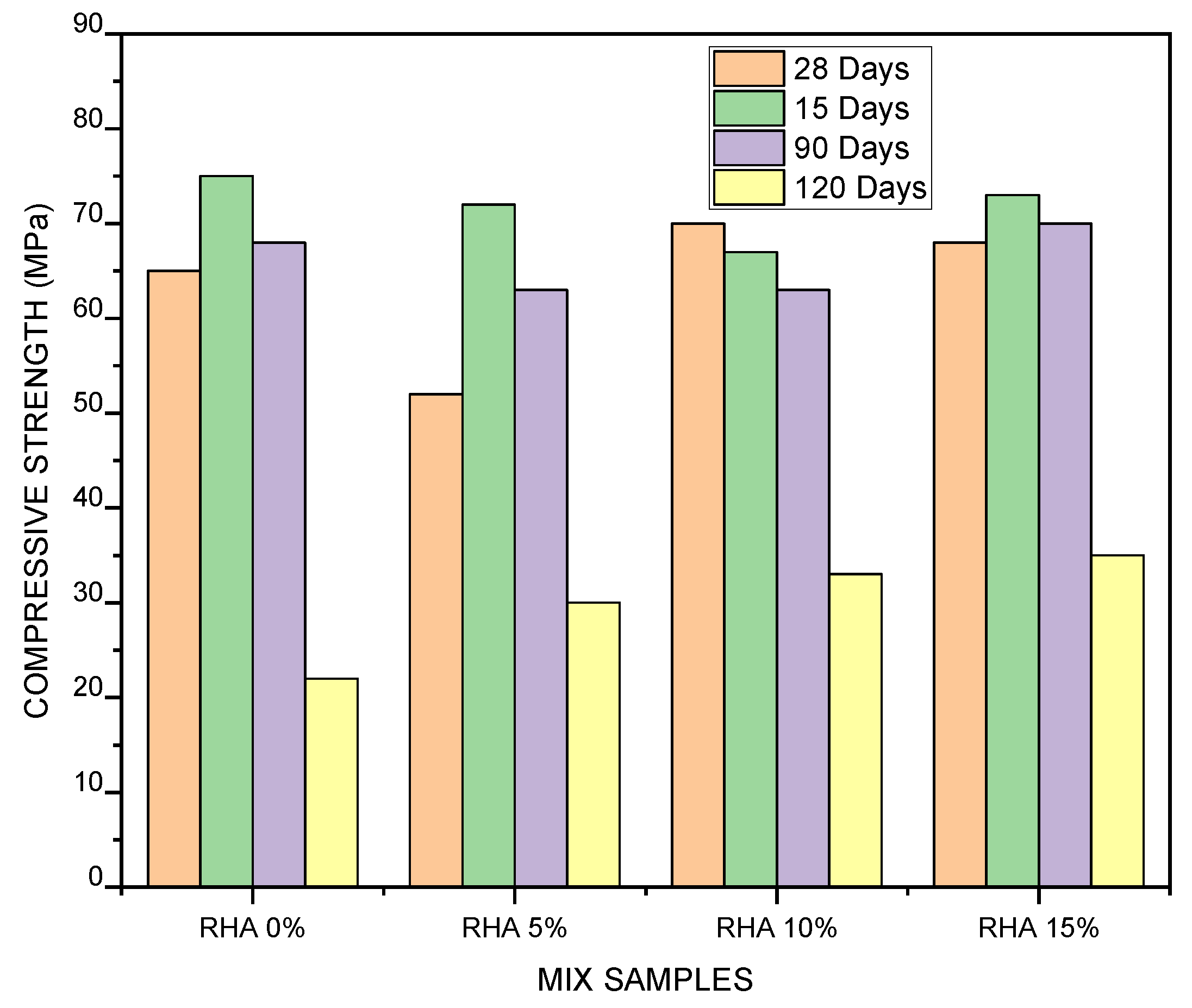
| References | Mean Particle Size (µm) | Specific Gravity (g/cm3) |
|---|---|---|
| [23] | 1–50 | 2.25–2.32 |
| [24] | - | 2.19 |
| [32] | - | 2.07 |
| [33] | 6.27 | 2.08 |
| [34] | - | 2.14 |
| [35] | - | 2.08 |
| [36] | - | 2.09 |
| [37] | >45 | 2.36 |
| [38] | <45 | 2.3 |
| [39] | - | 2.21 |
| [40] | - | 2.12 |
| [41] | <45 | 2.06 |
| [42] | - | 2.12 |
| [43] | - | 2.17 |
| [44] | <25 | 2.3 |
| [45] | 25 | 2.7 |
| Parameters | Percentage of RHA Replacement | ||||||
|---|---|---|---|---|---|---|---|
| 0 | 5 | 7 | 11.25 | 15 | 20.25 | 25 | |
| Residue on 45 µm sieve (%) | 17.87 | 14.7 | 14.63 | 12.13 | 17.63 | 15.7 | 10.87 |
| Fineness (m2/kg) | 330 | 410 | 409 | 494 | 497 | 509 | 550 |
| Soundness (mm) | 4 | 6 | 5 | 6 | 5 | 5 | 6 |
| Specific Gravity (g/cm3) | 3.19 | 3.09 | 2.97 | 2.94 | 2.89 | 2.8 | 2.69 |
| References | Chemical Composition | ||||||||||
|---|---|---|---|---|---|---|---|---|---|---|---|
| SiO2 | Al2O3 | Fe2O3 | CaO | MgO | SO3 | Na2O | K2O | Others | LoI | SiO2 + Al2O3 + Fe2O3 | |
| [27] | 87.22 | 0.70 | 1.68 | 2.12 | 1.18 | 0.04 | 0.20 | 1.12 | 1.52 | 1.06 | 89.6 |
| [32] | 91.15 | 0.41 | 0.21 | 0.41 | 0.45 | 0.45 | 0.05 | 6.25 | - | 0.45 | 91.77 |
| [33] | 87.89 | 0.19 | 0.28 | 0.73 | 0.47 | - | - | 3.43 | - | 4.36 | 88.36 |
| [35] | 83.74 | 0.29 | 0.67 | 0.74 | 0.86 | 0.87 | 0.091 | 2.84 | 0.51 | 8.39 | 84.7 |
| [36] | 84 | 1.35 | 1.45 | 3.17 | - | 0.92 | - | - | - | - | 86.8 |
| [39] | 90.16 | 0.11 | 0.41 | 1.01 | 0.27 | - | 0.12 | 0.65 | - | - | 90.68 |
| [42] | 74.35 | 1.379 | 1.029 | 1.39 | 1.06 | - | - | 3.51 | - | 1.50 | 76.758 |
| [43] | 93.6 | 0.2 | 0.3 | 0.8 | 0.4 | 0.1 | 0.7 | 1.1 | - | 2.5 | 94.1 |
| [45] | 90.6 | 1.7 | 0.7 | 0.1 | 0.8 | - | - | 2.4 | 2.65 | <6 | 93 |
| [47] | 85.3 | - | 0.817 | 1.42 | 0.81 | 0.23 | - | 2.37 | 4.881 | - | 86.117 |
| [48] | 86.73 | 0.04 | 0.61 | 0.39 | 0.08 | 1.32 | 9.76 | 0.01 | - | 0.54 | 87.38 |
| [49] | 81.8 | 0.38 | 0.78 | 1.8 | 0.9 | 0.56 | 0.05 | 3.1 | 5.56 | - | 82.96 |
| [50] | 93.5 | 0.55 | 0.23 | 1.11 | 0.31 | 0.07 | 0.1 | 1.4 | - | - | 94.28 |
| [51] | 87.8 | 0.4 | 0.3 | 0.7 | 0.6 | 0.1 | 0.5 | 2.2 | - | 2.2 | 88.5 |
| [52] | 88.07 | 1.35 | 0.22 | 1.04 | 0.74 | 0.49 | 1.15 | 2.02 | 2.31 | 2.61 | 89.64 |
| [53] | 86.98 | 0.84 | 0.73 | 1.4 | 0.57 | 0.24 | 0.11 | 2.46 | - | 5.14 | 88.55 |
| [54] | 96.84 | 1.03 | 0.38 | 0.47 | 0.32 | - | 0.03 | 0.81 | 0.1 | - | 98.25 |
| [55] | 87.8 | 0.4 | 0.3 | 0.7 | 0.6 | 0.1 | 0.5 | 2.2 | - | 2.2 | 88.5 |
| [56] | 94.91 | 0.37 | 0.79 | 0.98 | 0.26 | 0.09 | 0.02 | 1.67 | 0.85 | 0.06 | 96.07 |
| [57] | 91.56 | 0.19 | 0.17 | 1.07 | 0.65 | 0.47 | - | - | 4.89 | - | 91.92 |
| [58] | 92.19 | 0.09 | 0.10 | 0.09 | 0.41 | 0.41 | 1.64 | 0.05 | 0.72 | 4.14 | 92.38 |
| References | Microstructure of RHA Sample |
|---|---|
| [24] | Porous cellular structure. |
| [26] | A denser microstructure with excellent aggregate bonding and cement matrix observed. |
| [28] | Porous cellular structure. |
| [32] | More packed pore structure. |
| [33] | Irregular particles with micro-pores. |
| [37] | Highly porous material with a large internal surface area. |
| [39] | Irregular particles. |
| [58] | Interconnected pores and loosely packed geo-polymer matrix with rough flaky extended feature. |
| [62] | Cellular and porous structure, with a high specific surface. |
| [63] | Poorly densified and porous structure. |
| References | Mineralogical Compositions of RHA Sample |
|---|---|
| [23] | Amorphous and identified as quartz (SiO2). |
| [28] | Amorphous structures consist of cristobalite (SiO2). |
| [33] | Amorphous structures and identified as gypsum (soft sulphate mineral composed of calcium sulphate dehydrate) and ettringite (hydrous calcium aluminum sulphate mineral) in the surface pores. |
| [41] | In both, amorphous and crystalline forms identified as cristobalite (SiO2). |
| [43] | Amorphous structures consist of quartz (SiO2) and cristobalite (SiO2) minerals. |
| [49] | Amorphous and low crystallinity of the samples showed the peak value known to be the quartz (SiO2) primary. |
| [54] | Amorphous structures identified as calcium silicate hydrate (C-S-H) and calcium aluminate hydrate of C3ASH6 type. |
| [57] | Amorphous structures and identified as cristobalite (SiO2). |
| [58] | Amorphous structures and identified as quartz (SiO2), cristobalite (SiO2) and gibbsite (aluminum hydroxide—Al(OH)3). |
| [64] | In both, amorphous and crystalline forms identified as cristobalite (SiO2) and Fluorite. |
| [65] | Amorphous and identified as quartz and cristobalite (SiO2) seen on 2θ scale. |
| Parameters | Percentage of RHA Replacement | ||||||
|---|---|---|---|---|---|---|---|
| 0 | 5 | 7 | 11.25 | 15 | 20.25 | 25 | |
| Initial Setting Time (min) | 175 | 280 | 220 | 135 | 440 | 210 | 118 |
| Final Setting Time (min) | 250 | 425 | 360 | 225 | 725 | 293 | 338 |
| Consistency (%) | 25 | 26.8 | 29.2 | 30 | 30.4 | 31.4 | 33.6 |
| References | Material/s and Method/s | Result/s |
|---|---|---|
| [42] |
|
|
| [45] |
|
|
| [63] |
|
|
| [79] |
|
|
| [82] |
|
|
Disclaimer/Publisher’s Note: The statements, opinions and data contained in all publications are solely those of the individual author(s) and contributor(s) and not of MDPI and/or the editor(s). MDPI and/or the editor(s) disclaim responsibility for any injury to people or property resulting from any ideas, methods, instructions or products referred to in the content. |
© 2022 by the authors. Licensee MDPI, Basel, Switzerland. This article is an open access article distributed under the terms and conditions of the Creative Commons Attribution (CC BY) license (https://creativecommons.org/licenses/by/4.0/).
Share and Cite
Endale, S.A.; Taffese, W.Z.; Vo, D.-H.; Yehualaw, M.D. Rice Husk Ash in Concrete. Sustainability 2023, 15, 137. https://doi.org/10.3390/su15010137
Endale SA, Taffese WZ, Vo D-H, Yehualaw MD. Rice Husk Ash in Concrete. Sustainability. 2023; 15(1):137. https://doi.org/10.3390/su15010137
Chicago/Turabian StyleEndale, Solomon Asrat, Woubishet Zewdu Taffese, Duy-Hai Vo, and Mitiku Damtie Yehualaw. 2023. "Rice Husk Ash in Concrete" Sustainability 15, no. 1: 137. https://doi.org/10.3390/su15010137
APA StyleEndale, S. A., Taffese, W. Z., Vo, D.-H., & Yehualaw, M. D. (2023). Rice Husk Ash in Concrete. Sustainability, 15(1), 137. https://doi.org/10.3390/su15010137








